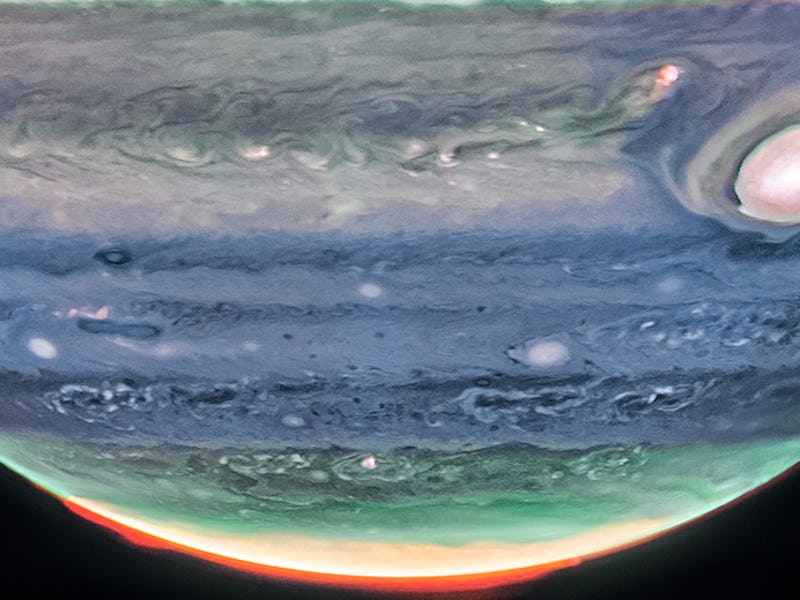The Webb Space Telescope Found A High-Speed, 3,000-Mile-Wide Jet Stream On Jupiter
Here’s what to make of this newly discovered, dazzling feature on the gas giant.

There’s always something new happening on Jupiter.
The Solar System’s largest planet is home to a high-speed, 3,000-mile-wide jet stream, pulsing near its equator. Scientists made this discovery using the ultra-sensitive instruments onboard the James Webb Space Telescope (JWST), an observatory from NASA, the European Space Agency, and the Canadian Space Agency. NASA announced the finding on Thursday.
This latest feature of Jupiter’s tempestuous atmosphere travels about 320 miles an hour, equivalent to the sustained winds of an Earthly Category 5 hurricane. The jet stream itself has never been seen before, according to the statement. It may reveal new insights about Jupiter’s turbulence.
NASA’s James Webb Space Telescope’s NIRCam (Near-Infrared Camera) studied Jupiter in July 2022.
Uncovering Jupiter’s tempestuous atmosphere
Jupiter is home to a dramatic atmosphere. Its most famous feature is the Great Red Spot, a storm system larger than Earth itself. The latest investigation into Jupiter’s chaos revealed a jet stream that NASA says has never been seen before.
“This is something that totally surprised us,” Ricardo Hueso, physics lecturer at the University of the Basque Country in Bilbao, Spain, said in NASA’s announcement. Hueso is the lead author of a new paper that describes the new work, published in the journal Nature Astronomy.
JWST orbits Earth, unlike other NASA missions designed to study Jupiter like the Juno probe that get far closer to the giant planet. Despite the distance, the telescope obtained a clear view.
“What we have always seen as blurred hazes in Jupiter’s atmosphere now appear as crisp features that we can track along with the planet’s fast rotation,” Hueso added.
According to the paper, Hueso and the team looked at data that JWST’s Near-Infrared Camera (NIRCam) took of Jupiter on July 27, 2022. This observation happened just weeks after the first images from the telescope dazzled the public. It was looking at the planet as part of the Jupiter System Early Release Science Program. NASA officials write that during the program, NIRCam snapped images of Jupiter 10 hours apart, roughly the same as one Jupiter day. By doing this in four different filters, JWST had enough data with which scientists could detect changes in small features at different altitudes.
These features are highlighted in new NASA imagery.
This image highlights several features around Jupiter’s equatorial zone that were clearly disturbed by the motion of the high-speed jet stream near the equator. The time stamps of the three sets of pullouts (colored orange, purple and yellow) show that in just ten hours, roughly one Jupiter rotation, the features significantly changed.
The telescope’s “exquisite resolution” was paired up with data that another major observatory, the Hubble Space Telescope, captured a day later and which created a baseline for scientists to make their assessments about what was going on at Jupiter’s equator.
“It’s amazing to me that, after years of tracking Jupiter’s clouds and winds from numerous observatories, we still have more to learn about Jupiter,” Leigh Fletcher, team member and planetary scientist at the University of Leicester in the United Kingdom, said in the statement. “And features like this jet can remain hidden from view until these new NIRCam images were taken in 2022.”
This article was originally published on